
Sant Engineering Innovation Laboratories
The 44,000-square-foot David G. Sant Engineering Innovation Building was completed in 2008. The four-story facility houses up to 20 state-of-the-art engineering labs and is home to USU’s premier makerspace—The Idea Factory. The facility also houses a class-1000 clean room and three conference rooms. Major funding was provided by David G. and Diann L. Sant for whom the facility is named.
Bionanotechnology Class-1000 Clean Room
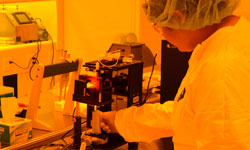
Manager: Elizabeth Vargis
Location: Sant 304
Phone: 435-797-8249
Email: elizabeth.vargis@usu.edu
Description: The cleanroom is a College of Engineering resource, used for building nano-microscale devices and developing materials in an environment with little to no pollutants. This space is used by biological, mechanical and electrical engineers. Funding sources include US Department of Energy (Nuclear Regulatory Commission), ORAU, the Knights Templar Eye Institute, SPIE, and NASA.
Learn more about the Bionanotechnology Class-1000 Clean Room
Biophotonics Laser Lab
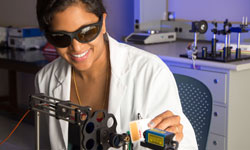
Director: Elizabeth Vargis
Location: Sant 002A
Phone: 435-797-8249
Email: elizabeth.vargis@usu.edu
Description: The Biophotonics Laser Lab is one of two basement-level Sant labs collectively known as the Vargis Labs. Researchers here are developing new ways to detect and diagnose factors that may cause disease using spectroscopy and electrophoresis. Funding sources include US Department of Energy (Nuclear Regulatory Commission), ORAU, the Knights Templar Eye Institute, SPIE, and NASA.
BRIDGE Lab

Director: Koushik Chakraborty
Location: Sant 310
Phone: 435-797-8249
Email: Koushik.Chakraborty@usu.edu
Description: The BRIDGE lab focuses on interdisciplinary research to create gateways between Computer Architecture and Physical Design Automation. The phenomenal growth of integration capacity accompanied with growth in design complexity has far outpaced the development in design automation tools and widely adopted design methodologies.
Communications Network Innovation Lab
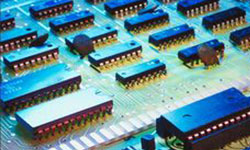
Director: Rose Hu
Location: Sant 312
Phone: 435-797-8249
Email: Rose.Hu@usu.edu
Description: The Communications Network Innovation Lab gives researchers the ability to model and test the latest concepts in wireless communications. Experts in this field are developing new ways to develop quality of experience-aware, spectrum-efficient and energy-efficient radio resource access schemes in next generation wireless networks with densely deployed underlay devices.
Information Dynamics Lab
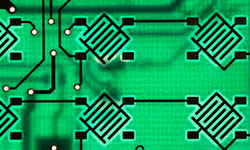
Director: Todd Moon
Location: Sant 210
Phone: 435-797-8249
Email: todd.moon@usu.edu
Description: The Information Dynamics Laboratory applies principles of statistical signal processing and communication theory to the extraction of information from signals from a variety of sources. Projects have included hyperspectral image processing, resulting in algorithms with improved detection of weak signals, and for temperature/emissivity separation; synthetic aperture radar algorithms for improving processing with polarimetric data; digital communications in very high interference settings; algorithms for fusing periodic data from multiple sensors; measuring a room using acoustic information; and improved techniques for video processing for distance education.
Structural Health Monitoring Lab
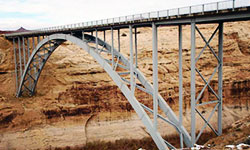
Director: Paul Barr
Location: Sant 108
Phone: 435-797-8249
Email: paul.barr@usu.edu
Description: The Structural Health Monitoring Lab is focused on collecting high-quality data to quantify the long-term behavior of structures. This data is being used to develop life cycle models and provide stakeholders with better decision making tools for maintenance.
Low Energy/Fault Tolerant Systems Lab
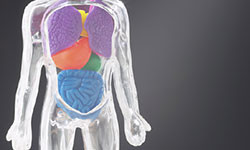
Director: Chris Winstead
Location: Sant 212
Phone: 435-797-8249
Email: Chris.Winstead@usu.edu
Description: Researchers in the Low-Energy/Fault-Tolerant Systems Lab study the tradeoffs between energy efficiency and reliability in computing and communication, with particular focus on micro-power signal processing and RF circuits for data communication in bio-implantable or wearable electronics. Biological systems are widely regarded as exceptional models for energy efficiency, so our research focuses heavily on the interface between electronics and biology.
Metabolic Analysis Lab
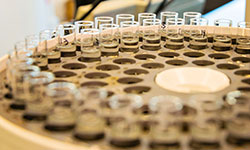
Director: Jixun Zhan
Location: Sant 306
Phone: 435-363-7573
Email: Jixun.Zhan@usu.edu
Description: This lab analyzes metabolic pathways that lead to the target compounds, which provides information for reconstitution and manipulation of these pathways in heterologous hosts. In addition, metabolites from engineered pathways will be processed and analyzed by HPLC in this lab.
Metabolic Engineering Lab

Director: Jixun Zhan
Location: Sant 302
Phone: 435-363-7573
Email: Jixun.Zhan@usu.edu
Description: This lab focuses on engineering the metabolic pathways in microorganism for the production of industrially or medicinally important molecules. Various synthetic biology and metabolic engineering tools are used to improve the production yields and generate new useful metabolites.
Radio Frequency Micro/Nano-Electromechanical Systems Lab
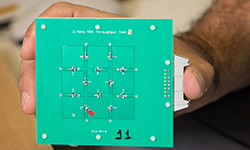
Director: Bedri Cetiner
Location: Sant 312
Phone: 435-797-8249
Email: bedri.cetiner@usu.edu
Description: From your cellphone, to the neighborhood police cruiser, to the small satellite orbiting overhead, nearly every mobile device needs antennas. Researchers in the Radio Frequency Micro/Nano-Electromechanical Systems Lab are developing tomorrow's smart antennas that can morph their shape and readily adapt to receive the correct signal and stay connected to other devices.
Remote Sensing Services Lab
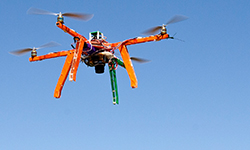
Tissue Engineering Lab
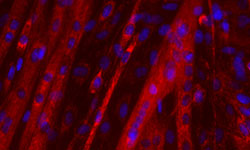
Director: Elizabeth Vargis
Office: Sant 004
Phone: 435-797-8249
Email: elizabeth.vargis@usu.edu
Description: The Tissue Engineering Lab is one of two basement-level Sant labs collectively known as the Vargis Labs. In this group, advanced methods to improve understanding of biological phenomena are used to model atrophy during muscle disuse or space travel and model retinal eye disease including age-related macular degeneration and retinopathy of prematurity. Funding sources include US Department of Energy (Nuclear Regulatory Commission), ORAU, the Knights Templar Eye Institute, SPIE, and NASA.

